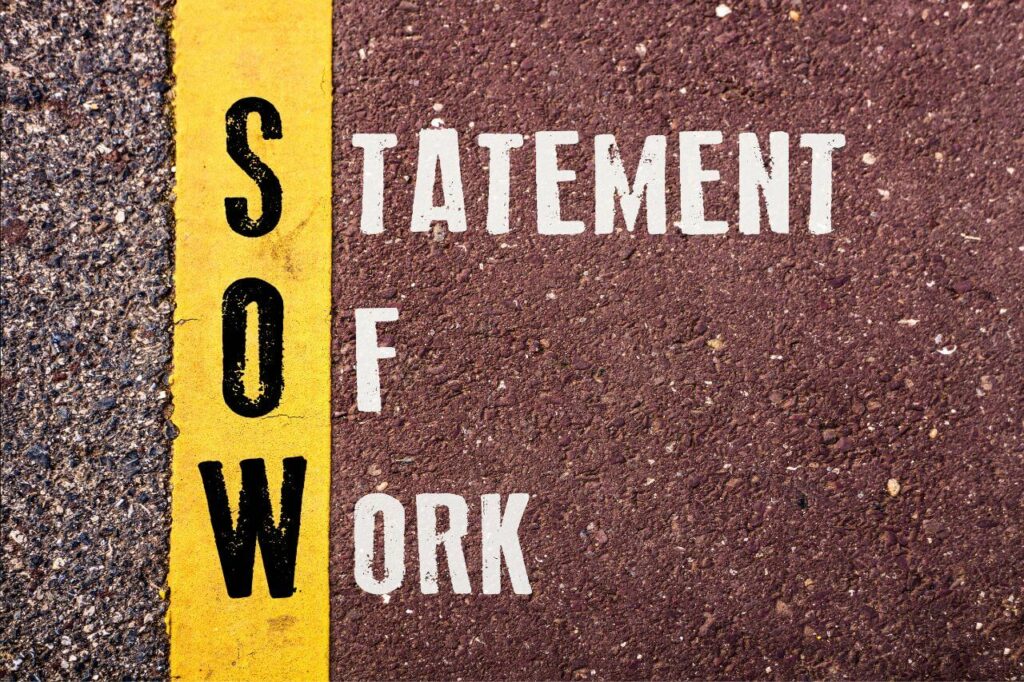The Statement of Work (SoW) and Scope of Work are two important documents used in project management. However, as terms, they’re also often used interchangeably despite having distinct differences.
Understanding each of them and the differences between them is key to having a firmer grasp and understanding of project management especially when dealing with contracts.
This blog post will provide an in-depth analysis of the Statement of Work vs Scope of Work, including their definitions, differences, and importance in project management.
Statement of Work vs Scope of Work: Overview
What is a Statement of Work (SoW) in Project Management?
According to the Project Management Book of Knowledge (PMBOK), a Statement of Work (SoW) is “a narrative description of products or services to be supplied under contract”.
It is a high-level formal project document that details the specific project objectives, tasks, timelines, and resources involved in a project.
An SoW is a crucial part of project management and is often used as a contractual agreement between a client and a service provider, or between different departments within an organization.
This document when well-crafted is a project guideline that helps prevent ambiguity and misunderstandings throughout the project lifecycle by providing clear instructions on the project’s mission, deliverables, and success criteria.

Key Components of a Statement of Work
Here are the key components of a Statement of Work:
- Project Overview: A brief description of the project, its purpose, and how it aligns with business objectives.
- Scope of Work: Detailed description of the work to be done, including project objectives, deliverables, tasks, and subtasks.
- Project Schedule: Key dates and milestones for project deliverables, including start and end dates.
- Payment Schedule: Detailed information about the project cost, payment terms, and schedule.
- Project Management: Details about project governance, including roles and responsibilities, reporting structures, and communication plans.
- Acceptance Criteria: A clear definition of what constitutes a successful project and how the final product or service will be accepted.
- Assumptions and Agreements: Any assumptions that were made during the project planning phase and the agreed-upon standards and procedures for work.
- Terms and Conditions: Any legal considerations, including confidentiality, intellectual property, or liability issues.
What is Scope of Work in Project Management?
In project management, the Scope of Work is a detailed description of the work that needs to be carried out to complete a project. It outlines the project’s specific activities, deliverables, and timelines, and sets the stage for project planning and execution.
This Scope of Work is an important part of the project plan and is often included in the project’s Statement of Work.
It’s also an essential tool for managing the project scope which helps in ensuring that all stakeholders have a clear understanding of what the project entails, which can help to prevent scope creep.

Key Components of a Scope of Work
Here are the key elements of a Scope of Work:
- Project Objectives: A clear statement of what the project is expected to achieve. This should align with the broader business or organizational goals.
- Deliverables: Detailed description of all project outputs. Deliverables could be tangible items like a software product, a report, or a physical structure, or intangible items like training.
- Tasks: Breakdown of all the tasks that need to be performed to deliver the project. This often involves breaking down the project into manageable sub-tasks.
- Timeline: Specific dates for when tasks and deliverables will be completed. This might also include dependencies between tasks and important project milestones.
- Resources: Details of all the resources required to complete the project. This could include human resources (team members, skills required), materials, equipment, or software.
- Costs: An estimate of the total cost of the project, including labor, materials, and other direct and indirect costs.
- Standards and Performance Requirements: Any industry or quality standards that the project must adhere to, and any performance or functionality requirements for project deliverables.
- Assumptions, Risks, and Constraints: Any assumptions made during the planning process, potential risks that could impact the project, and any constraints (like budget or time constraints) that the project must work within.

Statement of Work vs Scope of Work: Differences
Despite their similarities, the Statement of Work (SoW) and Scope of Work happen to have different focuses, purposes, and uses.
The SoW which is typically written from the client’s perspective, focuses on the work to be done, while the Scope of Work is written from the project team’s perspective and focuses on how the work will be done to meet the objectives and deliverables described in the SoW.
Key differences between these two project documents include:
1. Definition
The Statement of Work (SoW) is a formal document that provides an overview of the project, including its objectives, tasks, deliverables, timeline, and resources, and often serves as a contractual agreement between parties.
The Scope of Work on the other hand is a document that specifically outlines the work to be done for the project by detailing the tasks, deliverables, and timelines.
2. Purpose
The purpose of the SoW is to provide a holistic understanding of the project. It includes not only the project’s scope but also other aspects like payment terms, project management details, acceptance criteria, and key assumptions.
While the main purpose of the Scope of Work is to define the specific activities, deliverables, and timelines that the project will entail to fulfill the objective in the SoW. It focuses on “what” will be done in the project.
3. Content:
The contents of the SoW include the project objectives, Scope of Work, project schedule, payment schedule, project management details, acceptance criteria, terms and conditions, and assumptions.
While the Scope of Work includes project deliverables, tasks, timelines, and resources needed.
4. Usage
The SoW is often used as a contractual agreement between the client and the service provider or between different departments within a single organization.
The Scope of Work on the other hand is used as a guide for the project team to know exactly what tasks need to be completed and when.
What is the Importance of Statement of Work in Project Management?
There are several reasons why a Statement of Work is important to a project. Some of these reasons are:
- Defines Project Scope: A SoW provides a detailed description of the work to be done, the deliverables, the timeline, and the resources required. This helps to define the project’s scope, reducing the risk of misunderstandings or disagreements later on.
- Sets Clear Expectations: By outlining the project’s objectives, deliverables, and deadlines, the SoW sets clear expectations for all stakeholders to ensure that everyone involved in the project knows what is expected of them and when.
- Basis for Agreement: A SoW often serves as a contractual agreement between the client and the service provider so that both parties are on the same page and agree on what will be delivered, when it will be delivered, and how much it will cost.
- Mitigates Risks: By identifying potential risks and outlining strategies to manage them, a SoW can help to mitigate risks before they become issues.
- Guideline for Project Execution and Control: A SoW serves as a guideline for executing and controlling the project. It provides a roadmap that can be referred back to throughout the project lifecycle, helping to keep the project on track and within scope.
- Basis for Performance Measurement: The SoW defines the project’s deliverables and acceptance criteria, providing a basis for measuring the project’s performance.
- Communication Tool: A well-written SoW can serve as a powerful communication tool, ensuring that all stakeholders understand the project’s goals, deliverables, timelines, and responsibilities.
What is the Importance of Scope of Work in Project Management?
The Scope of Work is an essential component that defines the boundaries of the project. It outlines the specific tasks, deliverables, and timelines involved in a project. Here’s why it’s important:
- Clear Definition of Work: The Scope of Work outlines the tasks, deliverables, and timelines in detail. It ensures all project stakeholders understand precisely what work will be done, which is key to aligning expectations and preventing misunderstandings.
- Prevents Scope Creep: By defining the project’s boundaries, the Scope of Work helps prevent scope creep which is the tendency for the project to expand beyond its original objectives. By stating what is not included in the project, it helps keep the project focused and controlled.
- Resource Planning: The Scope of Work assists in estimating the resources needed – personnel, time, materials, etc., for each task. This aids in efficient project planning and budgeting.
- Establishes Timelines: The Scope of Work sets out the project schedule, including milestones and deadlines for deliverables. This helps keep the project on track and allows for better time management.
- Performance Measurement: The Scope of Work provides a basis for measuring project performance. By comparing actual results with the defined deliverables and timelines, it enables effective monitoring and control of the project.

How to Write a Statement of Work
When it comes to writing a Statement of Work, there are a few key steps to take to ensure that it accurately captures the project’s objectives, requirements, and expectations.
Here are some pointers on how to create a concise and effective SoW:
1. Begin with a concise project overview: Start the SoW by providing a brief overview of the project and its goals. This should include a high-level description of what work is required and why it is critical.
2. Define the project scope: The next step is to define the project scope, including what work is and is not included so that everyone is on the same page when it comes to the project’s goals and objectives.
3. Outline the following project deliverables: Following that, describe the specific deliverables that will be created as part of the project. These include reports, software, hardware, or any other tangible items that will be delivered at the end of the project could be included.
4. Include a project timeline: Include a timeline that outlines the project’s major milestones and deadlines to help keep the project on track and completed in time.
5. Define roles and responsibilities: Define the roles and responsibilities of all project participants, including the client, service provider, and any third-party vendors or subcontractors.
6. Clarify payment terms: Outline the payment terms and schedule, as well as any milestones or deliverables that will trigger payment.

How to Write a Scope of Work
Scope of work is an important part of project management which specifies the tasks, timelines, and resources needed to complete a project.
Follow these steps to create an effective scope of work:
1. Define the Project Goals and Objectives: The first step in writing a scope of work is to define the goals and objectives of the project.
These objectives must be specific, measurable, attainable, relevant, and time-bound (SMART). This will assist you in determining which tasks must be completed to meet the project’s objectives.
2. Identify Deliverables: The next step is to identify the project’s deliverables. Deliverables are tangible or intangible project outputs such as reports, designs, or software.
3. Break down into Tasks: Once the deliverables have been identified, you must decompose them into the tasks required to produce them.
4. Identify Dependencies: After you’ve identified the tasks, you should look for any dependencies between them.
Dependencies are task relationships in which one task cannot begin until another task is completed. Identifying dependencies will assist you in developing a realistic project schedule.
5. Estimate Time and Resources: Estimate the amount of time and resources needed to complete each task.
Personnel, materials, and equipment are all included. This will assist you in developing a project budget and timeline.
6. Define Acceptance Criteria: Define each deliverable’s acceptance criteria. This defines the specifications that must be met by the deliverables before they are accepted.
This will help to ensure that the project meets the expectations of the client.
7. Identify Potential Risks: Determine the risks that may jeopardize the project’s success. Potential issues include budget constraints, timeline issues, and personnel issues.
This will assist you in developing a risk management strategy to address these concerns.
How are they used Together in Project Management?
Despite their uniqueness and differences. the Statement of Work (SoW) and the Scope of Work happen to be complementary tools used in project management that, when used together, can help ensure a project runs smoothly and successfully.
The SoW serves as the anchor point for a project, providing a high-level overview of the project’s objectives, deliverables, timelines, and resources setting the fundamental expectations for the project and often forms part of a contractual agreement between the client and the service provider.
It is typically used during the project’s initiation and planning phases to establish the foundation of what the project aims to achieve and the broad strokes of how it will get there.
On the other hand, the Scope of Work is a more detailed document that breaks down the work to be done into specific tasks, deliverables, and timelines.
It serves as a roadmap for the project team, outlining exactly what needs to be done, by whom and when. The Scope of Work is typically used during the project’s execution and control phases to guide the team’s work, manage the project scope, and prevent scope creep.
In essence, the SoW sets the direction and expectations, while the Scope of Work provides the detailed plan for achieving them. Both documents work hand-in-hand to ensure clear communication, effective planning and execution, and ultimately, project success.
Conclusion
Also, understanding the differences and connections between a Statement of Work (SoW) and a Scope of Work is essential for effective project management.
While the SoW sets the overall direction and expectations, the Scope of Work provides a detailed raodmap for actually getting the work done. Using both of them appropriately can lead to clear communication, effective project execution, and overall project success.
FAQs
Is Statement of Work a Proposal?
No, a work statement is not a proposal. A proposal may include a Statement of Work, but the two serve different functions.
A proposal is typically a document used to persuade a potential client or customer to hire a service provider or buy a product, whereas a statement of work is a formal document that outlines the specific tasks, deliverables, and timeline for a previously agreed-upon project.
Is a SoW Legally Binding?
Yes, a Statement of Work (SoW) is a legally binding document that outlines a project’s specific tasks, deliverables, and timeline.
It serves as a contract between the client and the service provider, outlining what work will be done, who will do it, and how.





